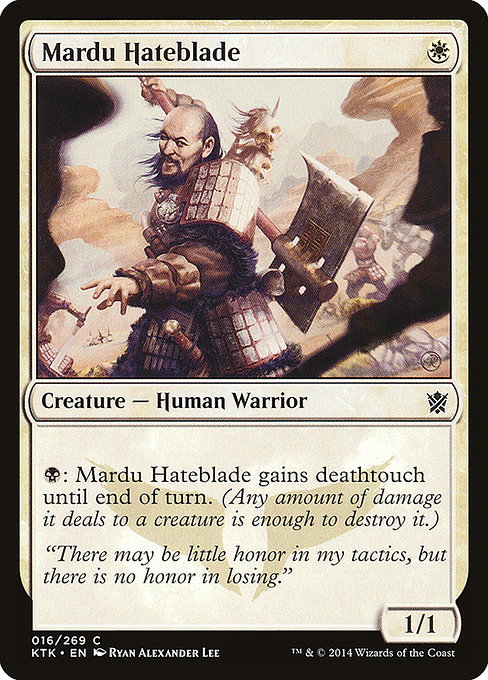
Image courtesy of Scryfall.com
Art reinterpretations in Secret Lair: a new lens on iconic MTG imagery
Secret Lair has long been a playground for artists and fans, offering reimagined takes on familiar cards and iconic moments. The idea is simple and electrifying: take a familiar frame and paint it with a new mood, a different palette, or a divergent cultural perspective. For collectors and players alike, these reinterpretations can transform a well-known card into a fresh conversation piece while still honoring the underlying mechanics and lore we love. 🧙♂️🔥💎
A closer look at the card profile: Mardu Hateblade
- Name: Mardu Hateblade
- Set: Khans of Tarkir (KTK)
- Mana cost: {W}
- Type: Creature — Human Warrior
- Rarity: Common
- Power/Toughness: 1/1
- Oracle text: {B}: This creature gains deathtouch until end of turn.
- Flavor text: "There may be little honor in my tactics, but there is no honor in losing."
- Colors and identity: Colors White (W) with Black color identity (B, W), watermark Mardu
- Artist: Ryan Alexander Lee
On first glance, hateblade is a tiny but potent emblem of Mardu's ruthless efficiency. A 1/1 for a single white mana isn’t flashy, but the tactic—granting deathtouch until end of turn by paying a black mana—turns this little warrior into a strategic sink or swim piece. It embodies Khans of Tarkir’s theme of wedge-colored tribes and fast, aggressive starts that punish slower development. The card’s art, color palette, and the subtle motion in the illustration all reinforce the Mardu ethos: speed, cunning, and a willingness to bend rules to win the fight. 🎲⚔️
From original art to reinterpretation: what Secret Lair explores
Secret Lair’s art reinterpretations invite players to re-see a familiar moment through another artist’s lens—often shifting mood, tone, or symbolism while preserving the card’s core function and lore. In the case of a wedge color pair like Mardu, reinterpretations might emphasize the faction’s shadowy, opportunistic side, or contrast the desert-warrior vibe with a bolder, more surreal aesthetic. This approach makes a staple card feel new on your table while maintaining the mechanical integrity that keeps it playable in formats where it matters. 🧙♂️🎨
Gameplay implications of the art-driven reimagining
Even as the art shifts, the way you deploy Mardu Hateblade in a deck remains grounded in its mana economics and ability window. In a typical Mardu or aggro deck, you want early pressure, and a 1/1 with a flexible ability can threaten a quick race plan. The deathtouch aura, available at the cost of a single black mana, makes it a stubborn blocker or a precise attacker against bigger foes—especially when you’re trying to shut down a red or green range of bigger threats while you push through with a few select evasive plays. The card's white mana commitment keeps it accessible in decks leaning into white's tempo, protection, or anthem-like effects, while its black bailout for deathtouch adds a tactical edge for one-turn blowouts. Strategy tip: pair Hateblade with other deathtouch or card-draw synergies to maximize value in a single exchange. 🔥
Flavor, lore, and the Secret Lair connection
The Mardu faction embodies a ruthless efficiency—speed, ambush, and brutal decisiveness. The flavor line captures that sentiment with a dry, practical edge: there may be little honor in my tactics, but there is no honor in losing. When an artist steps into a Secret Lair reinterpretation, they often lean into this pragmatic brutality while reimagining the warrior’s silhouette, weapon, or battlefield backdrop. It’s not just a new painting; it’s a narrative invitation to see a familiar warrior through a different cultural lens, a different color temperature, or a different moment in Tarkir’s war-swept timeline. 🎨🧭
Collectibility, value, and the collector’s mindset
As a common rarity from Khans of Tarkir, Mardu Hateblade isn’t typically a cornerstone for monetary speculation on its own. Current market signals place it in the approachable range for casual collectors and players still building their decks. Yet when a Secret Lair edition emerges—or even a reinterpretation variant—the perceived value can shift among fans who crave that unique art piece to complete a thematic shelf or a commander’s display. For many, the thrill isn’t just about the card on the battlefield; it’s about the story the image tells when you gaze across the table at a moment of high-stakes combat. 💎
Artist spotlight: Ryan Alexander Lee and the Tarkir moment
Ryan Alexander Lee’s work on this piece contributes to a broader tapestry of Tarkir’s history—an era defined by color-coded warbands, fast-paced combat, and a desert aesthetic that can crack the most protective playlines. In reinterpretations, Lee’s interpretation might emphasize the blade’s cadence, the stance of the warrior, or a play of light across the steel and leather. It’s a nod to the original while inviting players to see a different facet of the same sword-slinging routine we’ve known for years. The Secret Lair approach gives fans a chance to appreciate the artistry in a way that feels almost like collecting micro-moments from the multiverse. ⚔️🎨
Where to explore and connect
If you’re chasing new art perspectives or simply want to support the community of artists who keep MTG’s imagery vibrant, Secret Lair releases offer a frequent touchstone. And if you’re digging into the tactile world of gaming gear while you jam through drafts and commander games, rounds of tabletop play go better with a comfortable desk setup—and that neon mouse pad you’ve been eyeing could be the perfect companion for long nights of deck-building. The cross-promotion here blends two fan-friendly worlds: a tactile artifact for your desk and a powerful, portable creature for your board. 🧿
To explore the cross-promotion opportunity and see the product in action while you sharpen your play, consider the link below. It’s a nod to the same passion that fuels our love for these cards: design, strategy, and a little bit of luck on the draw.